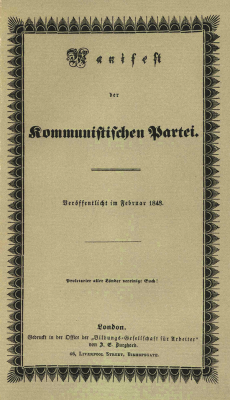The Communist Manifesto is a document containing the analysis of capitalism and the principles which underlie the outcry of the communist groups in Europe. It was written by the social philosophers Karl Marx and Friedrich Engels and published in 1848 after the Communist League had assigned the two to write a draft of its main principles.
Beginnings of the Manifesto
The Manifesto is the product of Marx and Engels’ collaboration in developing theories on what they believed was the first scientific attempt to establish an ideal society. It was written in Belgium during Marx’s exile due to his controversial political ideologies. It was brought to Germany by members of the Communist League. The first translation of the document came out in Swedish in 1848, and it was partially translated into English in 1850. A Russian translation of the document was published in 1869, and in 1872, a French translation came out of the press. In the latter part of the 19th century, its ideas became more widespread because of the growth of proletariat groups in many countries. Its popularity prompted Engels to describe it as the most famous product that came out of socialist literature. It became more widely read in the 20th century and became the fuel for social movements that demanded equality in place of exploitation.
Introduction
Marx and Engels opened the manifesto by announcing that a spirit was about to descend on Europe — the spirit of communism. They stated that the capitalist system had already seen communism as a danger to its power. Marx and Engels claimed that communism could overthrow the existing political and economic system, and that overthrow is exactly what the contents of the manifesto were aiming at.
Part One: The Proletariat and the Bourgeoisie
In the opening part of the manifesto, Marx and Engels describe how capitalism developed and how the exploitation between social classes came into being. According to the authors, all stages of human history are nothing but the history of battles between social classes. The old system of feudalism was brought down by a revolution, which made way for a new economic system composed of a new group of exploiters called the bourgeoisie, and an exploited class called the proletariat. The bourgeoisie owned the materials and means of production, while the proletariat provided the labor to create products. It was clear that the bourgeoisie failed to eliminate the division of classes and instead only created new classes and new methods of oppression. This observation made Marx and Engels conclude that the state was only an expression and instrument of the powerful class and helped in the exploitation of the proletariat. The proletariat, or workers, were then forced to sell their labor in the market, compelled to compete against each other in their efforts to gain employment.
This competition eroded the friendly relationship that used to exist between workers. In this way, workers become disposable and exchangeable. As the capitalist system expands and grows more powerful, its mechanisms of ownership and production will become more concentrated in a small minority. This would only funnel massive wealth into a few groups of people and leave the rest of the population in appalling poverty. Although Marx and Engels admitted that the capitalist system was far-reaching and powerful, they claimed that it was doomed to collapse. This collapse was ingrained in the system itself, with its ever-increasing exploitation of workers and the continuing aggregation of wealth into a few hands. The bourgeoisie was digging its own grave and ensuring the triumph of the proletariat. The authors pointed out that the collapse had already begun, as evidenced by the progress of the Communist Party.
Part Two: The Proletariat and Communists
In the second part of the manifesto, Marx and Engels state the goal of the Communist Party. They assert that the movement desires the betterment of society because it does not favor a particular group. Instead, it is only after the improvement of all workers as one single group. The proletariat will be solidified into a self-aware class with clearly delineated goals and interests. It will topple the bourgeoisie, take over political power, and reallocate it. To achieve these goals, the concept of private property must be abandoned. This concept of eradication of private property had been ridiculed by capitalists, which caused Marx and Engels to say that private property was already almost-nonexistent for the majority of the population because it was concentrated on the wealthy few. The authors berated capitalists for trying to preserve a system that denies property to most people.
Part Three: Commentaries on the Bourgeoisie
In this section, Marx and Engels lay down three kinds of analysis against the bourgeoisie. The first one is termed reactionary socialism, which the authors identify as either a reversion to the feudal system or a preservation of the present state of affairs. Either one runs in conflict with the aims of the Communist Party. The second analysis is called conservative or bourgeois socialism, wherein clever capitalists may seek to respond to the wrongs brought up by the proletariat in an attempt to retain their hold on power. Marx and Engels warned that humanitarians might promote this kind of movement only to make small changes rather than total change. The third one is called critical-utopian socialism or communism, after establishing new societies instead of revising the present system. The authors clarify that critical-utopian socialism or communism also runs contrary to the interests of the proletariat.
Part Four: The Communists’ Stance Regarding Other Parties Opposing Capitalism<
In the last part of the Communist Manifesto, Marx and Engels state that the Communist Party encourages and upholds all movements that seek to abolish the capitalist system. The authors end their influential document with the now immortal call to action: “The proletarians have nothing to lose but their chains. They have a world to win. Working Men of All Countries, Unite!”
